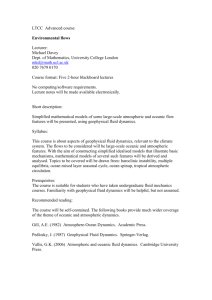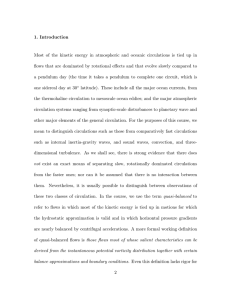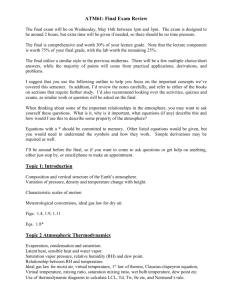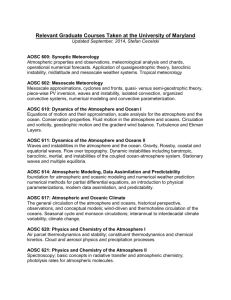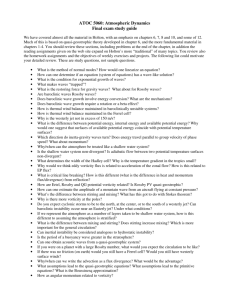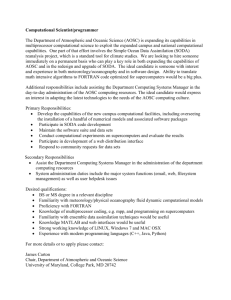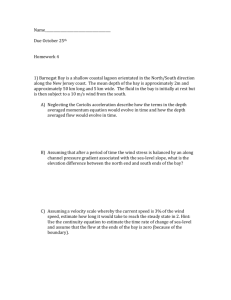Syllabus - Atmospheric and Oceanic Science
advertisement
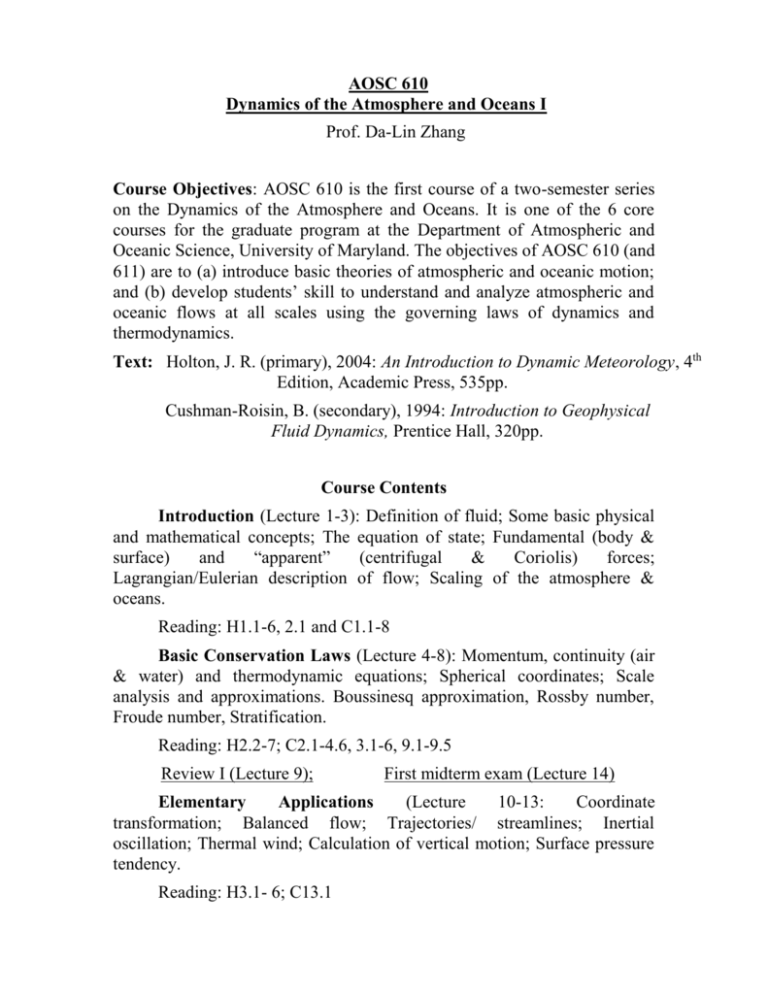
AOSC 610 Dynamics of the Atmosphere and Oceans I Prof. Da-Lin Zhang Course Objectives: AOSC 610 is the first course of a two-semester series on the Dynamics of the Atmosphere and Oceans. It is one of the 6 core courses for the graduate program at the Department of Atmospheric and Oceanic Science, University of Maryland. The objectives of AOSC 610 (and 611) are to (a) introduce basic theories of atmospheric and oceanic motion; and (b) develop students’ skill to understand and analyze atmospheric and oceanic flows at all scales using the governing laws of dynamics and thermodynamics. Text: Holton, J. R. (primary), 2004: An Introduction to Dynamic Meteorology, 4th Edition, Academic Press, 535pp. Cushman-Roisin, B. (secondary), 1994: Introduction to Geophysical Fluid Dynamics, Prentice Hall, 320pp. Course Contents Introduction (Lecture 1-3): Definition of fluid; Some basic physical and mathematical concepts; The equation of state; Fundamental (body & surface) and “apparent” (centrifugal & Coriolis) forces; Lagrangian/Eulerian description of flow; Scaling of the atmosphere & oceans. Reading: H1.1-6, 2.1 and C1.1-8 Basic Conservation Laws (Lecture 4-8): Momentum, continuity (air & water) and thermodynamic equations; Spherical coordinates; Scale analysis and approximations. Boussinesq approximation, Rossby number, Froude number, Stratification. Reading: H2.2-7; C2.1-4.6, 3.1-6, 9.1-9.5 Review I (Lecture 9); First midterm exam (Lecture 14) Elementary Applications (Lecture 10-13: Coordinate transformation; Balanced flow; Trajectories/ streamlines; Inertial oscillation; Thermal wind; Calculation of vertical motion; Surface pressure tendency. Reading: H3.1- 6; C13.1 Circulation and Vorticity (Lecture 15-21): Kelvin’s theorem; The vorticity equation; Barotropic and baroclinic Potential vorticity (PV) equations; Absolute & potential vorticity conserving trajectories across mountain barriers; Kinematics of 2-D flows. Reading: H4.1-6; C4.1-4, 12.2) Review II (Lecture 22); Second midterm exam (Lecture 28) Boundary Layer Dynamics (Lecture 23-32): Atmospheric/oceanic turbulence; Reynold’s averaging; Turbulent kinetic energy and Richardson number; Boundary-layer momentum equation; Well-mixed boundary layer; Ekman & surface layers; Secondary circulations and spin-down. Reading: H5-4; C5.1-6, 11.1-4 Quasi-geostrophic (QG) Analysis – atmosphere (Lecture 33-38): Observed structures of extratropical circulations; QG approximation & vorticity/PV equations; Geopotential tendency equation and the diagnostic -equation; Idealized model of baroclinic cyclogenesis. Reading: H6.1-5; C15.1-6 Quasi-geostrophic (QG) Analysis – Ocean (Lecture 39-42): Largescale ocean circulation, The Ekman transport, Wind-driven circulations: Sverdrup’s relation and Stommel’s model, Thermocline circulations and western boundary currents - the Gulf Stream, Upwelling and downwelling. Reading: C8.1-5, 14.1-4 Review III (Lecture 43) Final Exam Distribution of credits: 6 2 1 Assignments — 20% Mid-term — 40% Final — 40% ii
